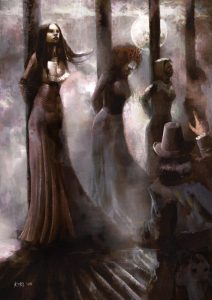
Every autumn folks become enamored with “witchcraft.” When the annual autumnal uptick is accompanied by the release of a popular book or movie like Hocus Pocus or Harry Potter interest in the occult skyrockets.
A surprising variety of traditions fall under the umbrella “witchcraft,” which encompasses everything from Sami Shamanism to Haitian Voodoo. You can see lists of the various religions HERE and HERE. To the best of my knowledge, Halloween isn’t a holy day for any of them.
Fictional stories, like the Harry Potter series, bear no resemblance to actual pagan religions. Sure, pagans enjoy dressing up and handing out candy as much as our Christian brethren. But that’s generally the extent of our participation. The influx of folks seeking admittance to “secret Halloween rituals” are left confused and disappointed. The only hocus pocus they’re likely to find on Halloween will be playing in theaters.
Few people realize Halloween’s origins are purely Christian and its customs uniquely American.
Halloween History
Between the 1st and 4th centuries, Christianity held feasts commemorating Christian martyrs and Saints at sporadic intervals, typically on the very sites where their blood was shed. To explain the change from many feast days to a consolidated date, Frances Stewart Mossier says, “Soon there were more martyrs than there were days in the year, and so one day was set apart in honor of them all and called All Saints’ Day.”
Pope Boniface IV established All Saints Day on May 13, 609, when he consecrated the Pantheon at Rome to the Blessed Virgin Mary and all the martyrs. The celebration of All Saints Day actually begins at evening vespers the day before. Originally called Halwenmesse Day, the name of the holy day was later shortened to Hallomas Day. Thus, Halloween is the shortened form of Hallomas-even.
Halloween is comprised of the words hallow (holy) and even (evening).
Owing to annual outbreaks of Roman Fever, which claimed many lives each summer, the Vatican decided it was prudent to have fewer pilgrims in the Holy City when the illness was at its peak. Spurred by public health concerns, Pope Gregory III moved All Saints Day from May to November in 731 AD. He established the new date (November 1st) by dedicating an oratory in Old St. Peter’s Basilica to the relics of all the Saints, martyrs, apostles, and confessors.
Since Hallowmas begin at evening vespers the prior day, October 31st became the new date for Hallows eve. Church bells rang for the souls in purgatory and criers dressed in black paraded through the streets tolling mournful bells, reminding Christians to pray for the souls of the dead.
All Saints Day became a holy day of obligation in 835 AD. By 1048, Odilo, Abbot of Cluny, established All Souls Day, expanding Allhallowtide, to All Saints Eve (October 31), All Saints Day (November 1), and All Souls Day (November 2).
Souling
In the Middle Ages, mumming was a common holiday practice in Europe, especially on Christian feast days. Mumming involves going door-to-door in costume and performing songs or plays in exchange for food or drink.
The feast days most commonly associated with mumming include: Hallowmas (Halloween), Christmas, Twelfth Night (Epiphany Eve), and Shrove Tuesday (Mardi Gras). This practice became known as caroling at Christmas and souling at Halloween. The line, “puling like a beggar at Hallowmas” in Two Gentlemen of Verona (1593) is a Shakespearean reference to souling.
 Soulers were bands of children who went door-to-door on Halloween, begging for money, apples, ale, or doles of cake. At each door they chanted, “Mercy on all Christian souls for a soul-cake.”
Soulers were bands of children who went door-to-door on Halloween, begging for money, apples, ale, or doles of cake. At each door they chanted, “Mercy on all Christian souls for a soul-cake.”
Soul-cakes are small cakes, about the size of a cupcake or muffin. In accord with the Lenten tradition of hot-cross-buns, they were marked with a cross and baked as alms. Often, they were blessed by a priest beforehand and given in exchange for praying for dead souls.
Soulers dressed in disguise, sang, performed plays, and carried hollowed-out turnip lanterns. The candle within the lantern represented souls trapped in purgatory. The plays re-enacted the death and resurrection of Christ, memorialized notable local dead, or re-enacted lives of the Saints. Because wearing disguises was so popular, souling became known as guising in many areas.
In 1891, Rev. M. P. Holme of Tattenhall, recorded a souling song performed by a child at the local school. Folklorist Lucy Broadwood published the tune and text two years later. In 1963, Peter, Paul, and Mary recorded the 1891 version and title it, “A’ Soalin.’”
[Chorus]
A soul! a soul! a soul-cake!
Please good Missis, a soul-cake!
An apple, a pear, a plum, or a cherry,
Any good thing to make us all merry.
One for Peter, two for Paul
Three for Him who made us all.
God bless the master of this house,
The misteress also,
And all the little children
That round your table grow.
Likewise young men and maidens,
Your cattle and your store;
And all that dwells within your gates,
We wish you ten times more.
[Chorus]
Down into the cellar,
And see what you can find,
If the barrels are not empty,
We hope you will prove kind.
We hope you will prove kind,
With your apples and strong beer,
And we’ll come no more a-souling
Till this time next year.
[Chorus]
The lanes are very dirty,
My shoes are very thin,
I’ve got a little pocket
To put a penny in.
If you haven’t got a penny,
A ha’penny will do;
If you haven’t get a ha’penny,
It’s God bless you.
You can see Peter, Paul, and Mary’s rendition below:
At its height, souling occurred across Europe from Britain to Austria. With the rise of Protestantism, the tradition of souling was abandoned in many areas.
The Reformation
Since Halloween is a Christian holy day, why do so many Christians shun the holiday? Two words: The Reformation. The Reformation posed a huge religious and political challenge to Catholicism, led to the rise of Protestantism, and signaled the end of the Middle Ages.
On October 31, 1517, Martin Luther nailed his publication of the Ninety-Five Theses of the Power and Efficacy of Indulgences to the door of Castle Church, governed by the Archbishop of Mainz in Wittenberg, Saxony. The essay heavily criticized the Church and the papacy. Among Luther’s many grievances were:
- Refusal to adhere to papal authority,
- Ceasing devotions to the Virgin Mary,
- Abandoning the concept of purgatory,
- Ending the intercession of and devotion to the Saints,
- Ending the practice of praying for the souls of the dead.

It is no coincidence that Luther nailed his Ninety-Five Theses to the church door on Hallows Eve prior to evening vespers.
In his attacks on Rome, Luther depicted himself as “good” in a struggle against an “evil” church. He wrote multiple tracts, pamphlets, and essays railing against the church between 1517 and 1521 employing propaganda, existing stereotypes, and cliches, all adapted as needed. The Reformation’s goal was to promote Luther’s agenda as *true* Christianity by claiming that Catholicism had succumbed to the evils of satanism.
On January 3, 1521, Pope Leo X excommunicated Martin Luther and condemned his followers. Spurred on by Luther’s propaganda, 18 holy wars were waged between Catholics and Protestants before his death on February 18, 1546. The wars continued long after Luther’s death, with another 33 holy wars taking place over the next 250 years.
Starting in 1605, Halloween was eclipsed by Guy Fawkes Night (November 5th) in England, which appropriated some of its customs. The ending of official ceremonies related to the intercession of Saints in England led Catholics and Protestants alike to develop new, unofficial Halloween customs.
The Puritans
The Puritan movement of the 16th and 17th centuries objected to ornamentation and ritual in church, insisting it was a form of idolatry. Even more strict than reformationists, Puritan separatists abandoned the Anglican Church of England and established a colony at Plymouth, Massachusetts in 1620.
 The Puritans regularly persecuted other faiths. In 1647, Massachusetts passed a law prohibiting Catholics from entering any territory under Puritan jurisdiction. Those unable to prove their Puritanism were banished from the colony—anyone who returned to the colonies after being banished was executed. The punishment for being Quaker was hanging. And there were, quite literally, witch hunts. Witch trials were more common in Puritanical justifications than any other areas. Numerous women were burned at the stake.
The Puritans regularly persecuted other faiths. In 1647, Massachusetts passed a law prohibiting Catholics from entering any territory under Puritan jurisdiction. Those unable to prove their Puritanism were banished from the colony—anyone who returned to the colonies after being banished was executed. The punishment for being Quaker was hanging. And there were, quite literally, witch hunts. Witch trials were more common in Puritanical justifications than any other areas. Numerous women were burned at the stake.
For Puritans, Hallows’ Eve was incompatible with Calvinist Doctrine—nor did they observe All Saints Day. According to Jack Santino, they believed, “Souls cannot be journeying from Purgatory on their way to Heaven, as Catholics frequently believe and assert. Instead, the so-called ghosts are thought to be in actuality evil spirits.” Thus, Halloween in America became associated with evil, witches, and ghosts—setting the stage for America’s unique Halloween traditions.
Irish Immigration
During the potato famine (1843 to 1855), over 1.5 million Irish refugees flowed into America. Ireland had remained largely Catholic and the Irish brought Catholicism with them when they immigrated. That enraged America’s protestant population. Conflict quickly erupted between Protestants and Catholics in the United States.
During the 1844 Philadelphia Bible riots, Anti-Catholic/Anti-Irish mobs destroyed houses and torched Catholic Churches. In New York, Archbishop John Hughes built a wall around Old St. Patrick’s Cathedral in order to protect it from protestant mobs and stationed armed guards at each of the city’s Catholic churches. Wild conspiracy theories took root, claiming Catholic priests strangled infants and held women as prisoners. The constant threat of violence prevented AllHallowtide traditions from emerging in America and reinforced the view that Catholic holy days were evil.
Some 70 years later, American author and historian Ruth Edna Kelley made the first reference to American souling in her book, The Book of Hallowe’en (1919). Ms. Kelley lived in Lynn, Massachusetts, a town filled with Irish and Scottish immigrants. She details the customs that arrived with the immigrants, “The taste in Hallowe’en festivities now is to study old traditions, and hold a Scotch party, using Burn’s poem Hallowe’en as a guide; or to go a-souling as the English used.”
In Europe, soulers only receive treats if they performed a song, joke, or party trick for the households. This differed significantly from the way souling evolved in America. In Ireland children said, “Help the Halloween Party.” In Canada, children say, “Halloween apples” or “La charité, s’il-vous-plaît” (Charity, please). Owing to America’s Puritanism, the jocular threat, “Trick-or-treat,” likely arose from the tensions between Catholic and Protenant households.
Halloween postcards produced in the 1920s commonly showed children but did not depict souling or guising. Guising did not become a widespread practice in America until the 1930s. Popular radio shows of the era portrayed children explaining guising to puzzled adults.
The Great Depression led to increasing hostility toward beggars. Newspapers from the mid-1930s to the mid-1940s, reported that many households viewed guising as a form of extortion, often reacting with anger. Owing to continued anti-Irish sentiment, sometimes even children protested. On Halloween 1948, the Madison Square Boys Club in New York City carried a parade banner through the streets that read “American Boys Don’t Beg.”
Modern Halloween
 Like Thanksgiving and Christmas, it was commercialization that propelled Halloween forward as secular holiday. Modern American Halloween imagery derives from the Puritanical insistence that All Saints Day was evil—filled with ghouls, ghosts, and witches. Early gothic and horror novels, such as Frankenstein and Dracula, were co-opted into the Halloween sphere by savvy marketers. Classic horror films such as Frankenstein (1931) and The Mummy (1932) were immensely popular and quickly added to the “ghoulish” Halloween scene.
Like Thanksgiving and Christmas, it was commercialization that propelled Halloween forward as secular holiday. Modern American Halloween imagery derives from the Puritanical insistence that All Saints Day was evil—filled with ghouls, ghosts, and witches. Early gothic and horror novels, such as Frankenstein and Dracula, were co-opted into the Halloween sphere by savvy marketers. Classic horror films such as Frankenstein (1931) and The Mummy (1932) were immensely popular and quickly added to the “ghoulish” Halloween scene.
During the 1930s, Halloween-themed haunted houses began to appear in America as paid attractions. Halloween episodes appeared on network radio programs such as The Baby Snooks Show (1946) and The Jack Benny Show (1948). In 1951, trick-or-treating was depicted in the Peanuts comic strip.
Halloween became firmly entrenched in popular culture in 1952, when Walt Disney created the cartoon Trick or Treat. Then, in 1969, Disneyland opened their Haunted Mansion attraction. In stark contrast to the banner-wielding boys from 1948, New Yorkers hosted the first annual Halloween Parade in 1974. Trick-or-treating soared in popularity in the 1980s, thanks to the release of the film E.T..
The National Retail Federation estimates that Americans will spend $10.6 billion on Halloween in 2022. According to their 2018 report, Americans spent $3.6 billion on costumes, of which $480 million was for pet costumes. The National Confectioners Association actively promotes giving sweets, instead of fruit, nuts, or baked goods. Consequently, Americans spend another $3.1 billion on candy. A whopping 93% of children, teenagers, and young adults plan to go trick-or-treating or participate in Halloween activities.
Christianity, Paganism, and Halloween
 Christian attitudes towards Halloween are diverse. Many Evangelicals and Fundamentalists wrongly believe Halloween is connected to paganism and the occult. Like their Puritan forebearers, they see Halloween as incompatible with Christian beliefs. For Catholics, Halloween’s Christian origins are acknowledged, though the commercialization surrounding the holy day now constitutes its own secular festival. Father Gabriele Amorth, an exorcist, says, “If English and American children like to dress up as witches and devils on one night of the year that is not a problem.”
Christian attitudes towards Halloween are diverse. Many Evangelicals and Fundamentalists wrongly believe Halloween is connected to paganism and the occult. Like their Puritan forebearers, they see Halloween as incompatible with Christian beliefs. For Catholics, Halloween’s Christian origins are acknowledged, though the commercialization surrounding the holy day now constitutes its own secular festival. Father Gabriele Amorth, an exorcist, says, “If English and American children like to dress up as witches and devils on one night of the year that is not a problem.”
True to form, Pagans hold no consistent views regarding Halloween. Many do not observe Halloween, owing to its Christian origins. Others believe, as the Catholics do, that it’s possible to observe their own autumnal celebrations and engage in the secular fun of Halloween, too.
If you’d like to learn about Samhain, a Celtic Holy Day that occurs around the same time as Halloween, visit my post: Samhain Lore.
